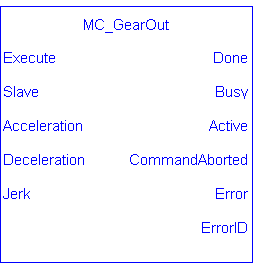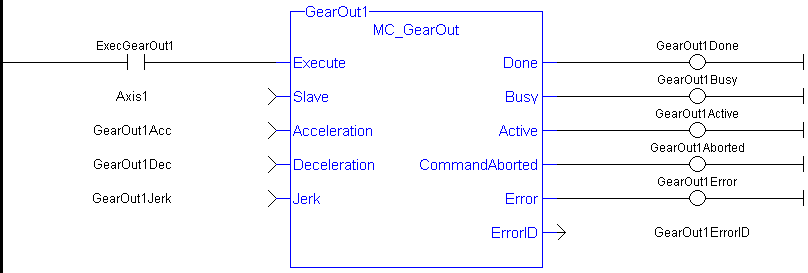 MC_GearOut
MC_GearOut
Description
- aborts the active MC_GearIn or MC_GearInPos move,
- disengages the axis from its master,
- and commands the axis to continue at its current velocity.
-
-
The current velocity is calculated by taking the average of the actual velocity during the previous 16 cycles.
Like a MC_MoveVelocity move, the control continues to command the axis to move at this velocity until this MC_GearOut move is aborted. The Acceleration, Deceleration and Jerk![]() In physics, jerk is the rate of change of acceleration; more precisely, the derivative of acceleration with respect to time input parameters are applied if this command velocity is modified by the MC_SetOverride function block. If this function block is called and the active move is not a MC_GearIn or MC_GearInPos move, this function block returns an error and the active move is not aborted.
In physics, jerk is the rate of change of acceleration; more precisely, the derivative of acceleration with respect to time input parameters are applied if this command velocity is modified by the MC_SetOverride function block. If this function block is called and the active move is not a MC_GearIn or MC_GearInPos move, this function block returns an error and the active move is not aborted.
-
-
The MC_GearOut is done when the slave axis is disengaged from the master axis. Once done, the MC_GearOut will remain busy and active until it is aborted by a different motion function block. This is different behavior than most other motion function blocks. The MC_GearOut function block represents an exception to the exclusivity rule as the Done and Active outputs may be true at the same time.

Figure 7-152: MC_GearOut
-
- This function block starts a motion-related action and therefore stores data for calculations and error checking.
See Call Function Blocks Multiple Times in the Same Cycle if using a dual-core controller.
Arguments
See Function Blocks - General Rules for more information about how inputs and outputs work.
Input
|
Execute |
Description |
Requests to disengage the slave axis from a MC_GearIn or MC_GearInPos move |
|
Data type |
BOOL |
|
|
Range |
0, 1 |
|
|
Unit |
N/A |
|
|
Default |
— |
|
|
Slave |
Description |
Name of a declared instance of the AXIS_REF library function (for more details, Axis Name and Number) |
|
Data type |
||
|
Range |
[1,256] |
|
|
Unit |
N/A |
|
|
Default |
— |
|
|
Acceleration |
Description |
Trapezoidal: Acceleration rate S-curve: Maximum acceleration |
|
Data type |
LREAL |
|
|
Range |
— |
|
|
Unit |
User unit/sec2 |
|
|
Default |
— |
|
|
Deceleration |
Description |
Trapezoidal: Deceleration rate S-curve: Unused |
|
Data type |
LREAL |
|
|
Range |
— |
|
|
Unit |
User unit/sec2 |
|
|
Default |
— |
|
|
Jerk |
Description |
Trapezoidal: 0 S-curve: Constant jerk |
|
Data type |
LREAL |
|
|
Range |
— |
|
|
Unit |
User unit/sec3 |
|
|
Default |
— |
Output
|
Done |
Description |
Indicates the axis is disengaged from its master |
|
Data type |
BOOL |
|
|
Busy |
Description |
Indicates the function is executing |
|
Data type |
BOOL |
|
|
Active |
Description |
Indicates this move is the Active move |
|
Data type |
BOOL |
|
|
CommandAborted |
Description |
Indicates the move was aborted |
|
Data type |
BOOL |
|
|
Error |
Description |
Indicates an invalid input was specified or no MC_GearIn or MC_GearInPos move is active |
|
Data type |
BOOL |
|
|
ErrorID |
Description |
Indicates the error if Error output is set to TRUE
|
|
Data type |
INT |
Example
Structured Text
(* MC_GearOut ST example *)
Inst_MC_GearOut(ExecGearOut1,Axis1,GearOut1Acc,GearOut1Dec,GearOut1Jerk);
//Inst_MC_GearOut is instance of MC_GearOut
Ladder Diagram








